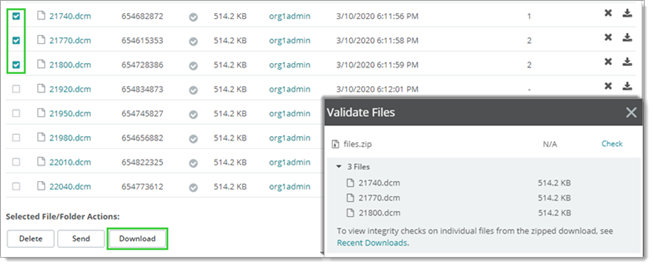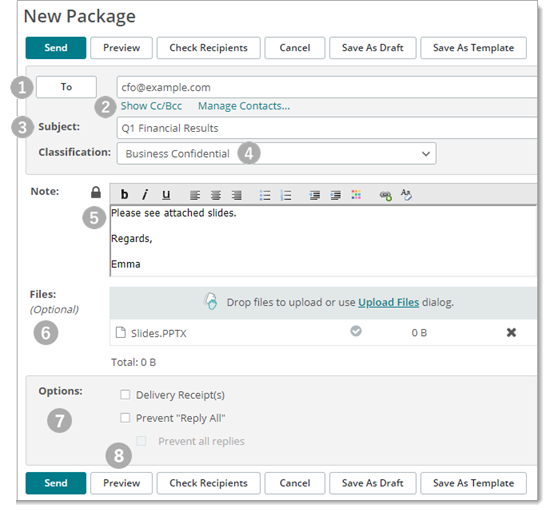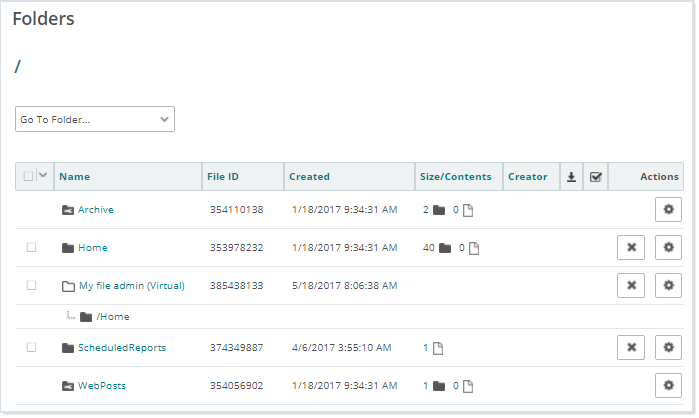The FOLDERS page enables you to select and view any folders that you have access to. Permissions assigned by your administrator determine actions you can apply to this view and its contents.
 Choose. Select a folder to browse and manage.
Choose. Select a folder to browse and manage. ![]()
Use the Go To Folder drop-down list to go to your favorite MOVEit Transfer folders. (Your home or default folder is the default.)
Note: If you have access to a large number of folders, the Go To Folder drop-down selector does not appear. Instead, you can type in the first few letters of the folder you are looking for into the Find File/Folder box.
 View. View folder details, history, and contents.
View. View folder details, history, and contents.
![]()
 ) present for files whose integrity was verified.
) present for files whose integrity was verified.Note: If content scanning is enabled, files that pass the content scan (Anti-Virus and/or Data Loss Prevention scans) are marked with this icon ![]() . Files that fail the scan are marked with a warning icon
. Files that fail the scan are marked with a warning icon ![]() .
.
 ) The number of times the file has been downloaded
) The number of times the file has been downloadedNote: Even though someone else has downloaded a certain file, it may still be "new" to you. This statistic is often used to quickly see what the most popular downloads in a given folder are.
 ): Indicates if file was uploaded with integrity checking.
): Indicates if file was uploaded with integrity checking. Manage. Add new folders, edit, copy, move, and delete.
Manage. Add new folders, edit, copy, move, and delete.
Folder types:
Folder actions:
 Download. Download selected files.
Download. Download selected files.
Download files securely with MOVEit Transfer. MOVEit Transfer provides a download summary in the Validate Files dialog. You can find these files in the default download location configured for your browser or platform.
![]() The Check link (optional) helps you apply a whole-file integrity check after you download a file. It is an independent step of information assurance aside from routine checks applied during data transport and data transfer.
The Check link (optional) helps you apply a whole-file integrity check after you download a file. It is an independent step of information assurance aside from routine checks applied during data transport and data transfer.
Files Can Be Downloaded Individually, Grouped, or Zipped (group download shown)

Most file downloads begin with a notification sent to a designated user or team (group).
|
New file notification |
Click (or copy into your web browser) the link sent in the email. This link takes you directly to the file referenced in the email (after you sign-on). |
|
Shared folder notification |
If another user shares a folder with you, you can access and browse the contents of the folder through the link in the shared folder notification email (which will bring you to the FOLDERS page). |
|
FOLDERS page |
Select a folder containing the file and click 'download' ( |
|
Search |
Search for the file name or file ID for any files you have access to, then download. |
![]() If you can't find a file, search for it in the Find File/Folder box (in the left navigation area). Enter either the NAME of the file (for example, "readme.txt") or the MOVEit Transfer FILEID (a unique identifier for the file, for example, 1234567) and click the magnifying glass to search.
If you can't find a file, search for it in the Find File/Folder box (in the left navigation area). Enter either the NAME of the file (for example, "readme.txt") or the MOVEit Transfer FILEID (a unique identifier for the file, for example, 1234567) and click the magnifying glass to search.
Download Files from Shared Folders (from notification email to user download shown)
You can apply an optional integrity check as an extra measure of assurance. The check is a whole-file measure to ensures the "file image" did not change during transit. You can use the optional Check link in the Validate Files dialog to verify there is no difference between the pre and post-transfer likeness of a file you downloaded. This Check can be bypassed, or you can perform the check later from the Recent Downloads view.
The built-in download capability (sometimes referred to in this document as the "JavaScript Wizard") does not check download integrity automatically. When you download a file, a Validate Files window opens. After the file finishes downloading, optionally click Check. Locate and select the downloaded file. A green checkmark indicates that the integrity check succeeded. A red "X" indicates a failed integrity check.
Optional Integrity Check (integrity check on zipped file shown)

You can also perform integrity checks on Recent Downloads from MOVEit Transfer if enabled.
Note: See Configure the Upload/Download Wizard to determine which wizard is enabled on your system (if any), and how to install, enable, or disable the wizard.
Important! The ActiveX Wizard works with Internet Explorer only. It is provided for purposes of backward compatibility with legacy MOVEit Transfer sites. It is best practice to use the built-in upload/download manager ("Javascript Wizard") instead.
Use of ActiveX Wizard is deprecated. For more information, see the Internet Explorer Add-on section.
 Upload. Upload files and folders.
Upload. Upload files and folders.
|
Drag-n-drop zone (WebUI shown)
|
![]() For keyboard-only systems, use the Tab key to browse and select the next item on the page, the Enter key to press buttons (once selected), and Spacebar to check or clear a checkbox.
For keyboard-only systems, use the Tab key to browse and select the next item on the page, the Enter key to press buttons (once selected), and Spacebar to check or clear a checkbox.
Uploading a file to a folder can trigger notification events to you, a group, or other users associated with the folder. The following table lists some of these notification events.
Notification Type |
Description |
Upload Confirmation |
You might get an email message called an upload confirmation when you upload your file. This option is turned off by default. |
New File Notification |
Other users might get an email message called a new file notification when you upload your file. This option is turned on by default. However, you will NOT get a new file notification if you upload a file into your OWN home folder. |
Delivery Receipt |
When someone downloads your file from MOVEit, you might receive a delivery receipt message. This option is turned off by default. |
File Not Downloaded Warning |
If your file has not been downloaded within a set amount of time, you might receive a "not downloaded yet" message to warn you that the person or process you expected to pick up your file has not yet picked it up. This option is turned off by default. It is useful for cases where a package or file download has an expiration date associated with it. |
Delivery Notification |
If Ad Hoc Transfer is enabled, you might receive an email message called a delivery notification when a message recipient reads a package or downloads a file from the package. |
If your administrator has enabled content scanning, and a virus or data policy violation is detected in a file you selected for upload, the browser displays an error and either blocks or quarantines the file. Filenames and entries in the Notes field are also scanned for data policy violations. If the content scan results in a file being quarantined, it will be uploaded, but the file will not be available for download. If the content scan results in a file being blocked, you receive the message Blocked for DLP Violation.
 Send. Send selected files in a new package.
Send. Send selected files in a new package.
Sending a package is like sending an email with attachments.
The Package Actions panel can appear on your Home page, the Packages page, or both:
|
|
|
![]() Features and fields in the New Package dialog can vary based on your organization policy and your level of permissions. Your MOVEit Transfer administrator and site policy can determine options available when you send a package.
Features and fields in the New Package dialog can vary based on your organization policy and your level of permissions. Your MOVEit Transfer administrator and site policy can determine options available when you send a package.
![]() For keyboard-only systems, use the Tab key to browse and select the next item on the page, the Enter key to press buttons (once selected), and Spacebar to check or clear a checkbox.
For keyboard-only systems, use the Tab key to browse and select the next item on the page, the Enter key to press buttons (once selected), and Spacebar to check or clear a checkbox.
New Package Dialog (WebUI shown)

# |
Description |
1. |
To: Include an email address for each recipient. Use a comma (",") to create a list if you have more than one group's or user's email address. If your organization has the Address Book feature configured, click the To, CC, or BCC fields and select an address from the dropdown list. From: (not shown in this figure) The From field is available if you have access to another user's mailbox (shared mailboxes is enabled). Click to select a user to be listed as the package sender. If the From field is not available, the package lists you as the sender. |
2. |
Show CC and BCC adds these fields to the page. Recipients cannot view BCC recipients. |
3. |
Subject Description of the package. Appears in the new package notification email, and identifies the package in package lists. |
4. |
Classification A business impact or information security marking you select for this package.
|
5. |
Padlock icon
|
6. |
Files List the number of attached files that you added. The way you add files depends on whether you have enabled a wizard. Note: If no wizard is enabled, click Choose File or Browse, select a file, and click Upload. For more information, see Upload a File Without the Wizard. Launch the Upload Wizard This link is available if you have enabled a wizard. Click to open the wizard. In the wizard, drag and drop files, or click Add File to locate and select files. For details about the available wizards, and how to enable and use them, see
|
7. |
Options The options that appear depend on how your organization is configured. If an option has been locked by the administrator, the value appears, but you cannot change it.
|
8. |
Preview Shows what your note will look like to recipients. On the Preview page, click Edit to make changes. |
|
Check Recipients Verifies that the email address you entered are valid. |
Save as Draft Saves the package as a draft. You can open it from the Drafts mailbox. Drafts can be edited or sent. After a draft is sent, it is deleted from the Drafts mailbox. |
|
Save as Template Saves the package as a template in the Templates mailbox. You can open a template, edit it, and send it. The original template remains unaltered in the Templates mailbox. |
If you sent a package to an unregistered recipient (that is, recipients that are not MOVEit users) you might be prompted to provide a password. The Provide Password page opens.
If you select this option, send the suggested password to the recipient.
If you select this option, follow the requirements and type a custom password two times. Send this password to the recipient.
Important: For this option, you must provide the password to the unregistered recipients by sending it as a separate email, phone call, FAX, and so on in accordance with your organization's security policy.
When the Send button is clicked, MOVEit uses the following rules to reconcile each email address as a package recipient:
 Share. Provide folder access to regular users, temp users, and groups.
Share. Provide folder access to regular users, temp users, and groups.
Share folders in just a few steps:
|
Open a folder. From MOVEit Transfer, open a folder.
|
|
Edit parent or subfolder settings. Edit sharing settings (View/Apply Share Settings, Folder Sharing Walkthrough) for any of the following:
|
|
Break chained permissions model (if necessary). To share a folder that uses its parent folder share settings (default), you must opt to make those folder share and access settings Custom. For example:
|
|
Add users and groups. Edit/control the access list.
|
 Find. Find files or folders.
Find. Find files or folders.
The Find File/Folder box (typically located in the left Navigation pane) lets you search the MOVEit system for files and folders using an ID (for example, 1234567) or a name (myfile.txt).

Name wildcards (*) are allowed. For example, you can search for *.pdf, myfile* or Home/John Smith/*.
If you searched for a file, the resulting file list has the following columns:
If you searched for a folder, the resulting folder list has only one column, containing the full path of the folders matching the search string. To view the folder, click the folder path.
In the following situations, wildcard characters are automatically added to a search term:
/) does not return any results, and the same search term with an asterisk appended also does not return any results, an asterisk is prepended to the search term if one does not already exist, and the search is retried. This allows users to search for partial folder paths.Note: For WebPost and Archived Logs folders, selected files are downloaded as a single bundle file using the As Format option to determine the format of the resulting file. This download process does not use the MOVEit Download Wizard.

Apply a sorting modifier to select All files, only New files, only Old files, or None to deselect all files. Similarly, you can select All folders, only Empty folders, only Not Empty folders, or None to deselect all folders.